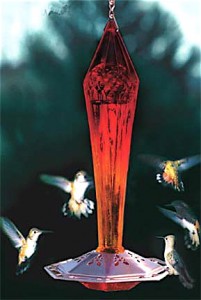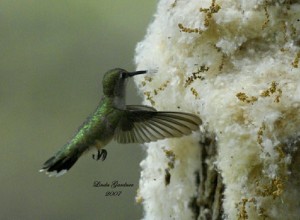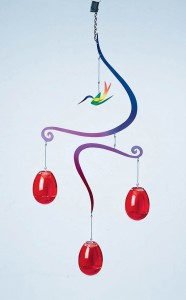- Bird Accessories, Bird Feeders, Hummingbird Feeders, Misters and Birdbath Drippers, Uncategorized, Wild Bird Feeders
Now is the Time for Hummingbird Feeders
If you’re wanting to attract hummingbirds this spring, now is the time to get your feeders ready. Hummingbirds are the most anticipated spring arrival of all wild birds, as they’re just remarkable beings of nature. So tiny, yet so brave, they’ll buzz closely when you hang your feeder. With amazing flight abilities, they’ll hover, fly forward and backwards, and even upside down!
It’s fairly easy to attract hummingbirds, even for beginners, with these easy tips:
Be sure to hang your feeders early. Hummingbirds first arriving in spring are hungry from their long migration out of Central and South America and Mexico. Natural food sources (insects and nectar from flowers) are in short supply at this time of year, making stops at your hummingbird feeder more favorable. Early April is best for southern states, while early May is best for the northern states.
Keep Nectar Fresh. Many hummingbird mixes are available for convenience, but it’s pretty easy to make your own too. Using 4 parts water to 1 part white table sugar-you can boil the water to dissolve sugar quickly and completely. Don’t ever use dyes, or any other ingredient, as it will likely be fatal. Hang feeders in the shade if possible, but still in easy view, and change the solution at 4 day intervals-minimum. Don’t let the sugar water sit too long as it spoils quickly in warmer weather.
Plant Hummer-Friendly Flowers. Red is always best, but hummingbirds know where the nectar can be found. Impatients are always a good choice, as are petunias, salvia, and geraniums. Trumpet vine and honeysuckle are adored by hummers too, but will not bloom until later in the season.
Add Moving Water to your garden. With the addition of a dripper in your bird bath, or a leaf mister set in the yard, you’ll be surprised just how much hummingbird activity will be seen. To bathe, drink, and play in the water is a much loved activity of the tiny jewel!
Please hang feeders high enough so that ground predators (cats) will not have an easy target.
- Bird Accessories, Hummingbird Feeders, Misters and Birdbath Drippers, Nesting Material, Uncategorized
Besides Sugar Water, Hummingbirds Love….
Hummingbird With Nesting Material There are several things you can do to attract and keep more hummingbirds around your yard. First would be habitat, by planting flowers that provide nectar for them to feed on. Certain trees, shrubs and vines are adored by hummers, and some perennials include:
* Canna * Four O’Clocks * Little Cigar
* Cardinal Flower * Foxglove * Lupine
* Columbine * Hosta * Penstemon
* Coral Bells * Hummingbird Mint * YuccaWater is fairly inexpensive, and just by adding a mister attachment to your outdoor faucet, you’ll see hummingbirds return daily to bathe and play in the fine mist. These are visual magnets for the tiny jewels!
Another wild bird accessory is nesting material. There is a new product called Hummer Helper, which has actually been endorsed by The Hummingbird Society.
“It is aimed at encouraging hummingbird nesting in a natural way. It has the potenial to help you bring in more hummers, where you can observe them, and then to increase the odds that they will nest near you. The latter also ssures more fledglings will visit your hummingbird feeders. Ans since hummers practice site fidelity-and return to the same site every year, you could see an increasing number of hummingbirds in the future.”
-
Functional Sculpture for Your Yard
People like to hang things in their yards….we see it all the time. Wind chimes, wind socks, flags, and the usual suspects, birdhouses and feeders. With hummingbird season approaching (starting now in the southeast region) it’s time to hang them as well.
This very cool hummingbird feeder is whimsical garden art, that is totally functional too. The pods look small but hold 10 ounces of nectar each. They have a special UV coating that resists fading or scratches, to keep them looking new.
A neat sculptural mobile to feed your hungry hummers. What will they think of next?

 If you’re wanting to attract hummingbirds this spring, now is the time to get your feeders ready. Hummingbirds are the most anticipated spring arrival of all wild birds, as they’re just remarkable beings of nature. So tiny, yet so brave, they’ll buzz closely when you hang your feeder. With amazing flight abilities, they’ll hover, fly forward and backwards, and even upside down!
If you’re wanting to attract hummingbirds this spring, now is the time to get your feeders ready. Hummingbirds are the most anticipated spring arrival of all wild birds, as they’re just remarkable beings of nature. So tiny, yet so brave, they’ll buzz closely when you hang your feeder. With amazing flight abilities, they’ll hover, fly forward and backwards, and even upside down!
 People like to hang things in their yards….we see it all the time. Wind chimes, wind socks, flags, and the usual suspects, birdhouses and feeders. With hummingbird season approaching (starting now in the southeast region) it’s time to hang them as well.
People like to hang things in their yards….we see it all the time. Wind chimes, wind socks, flags, and the usual suspects, birdhouses and feeders. With hummingbird season approaching (starting now in the southeast region) it’s time to hang them as well.